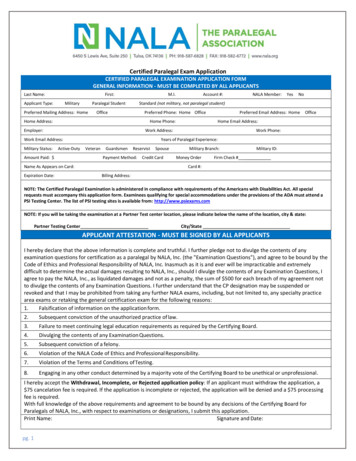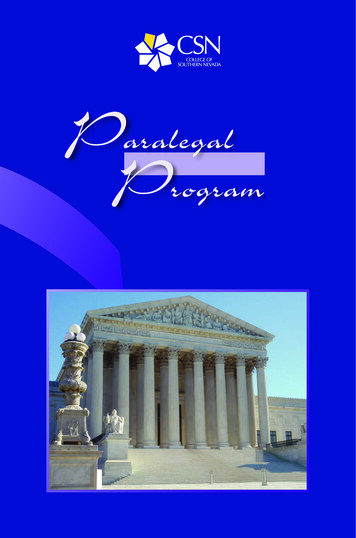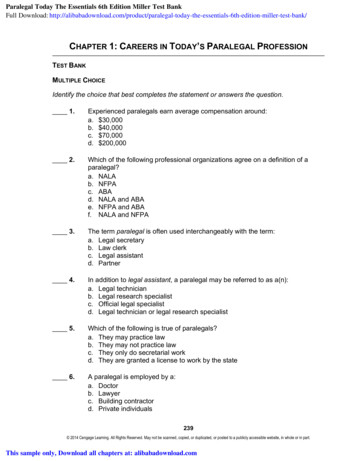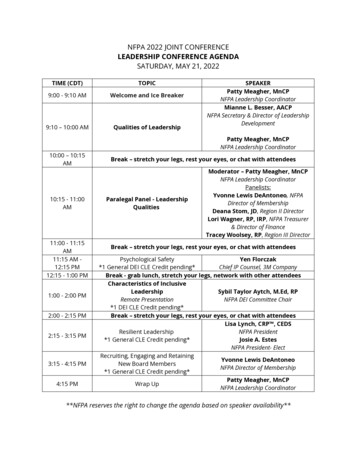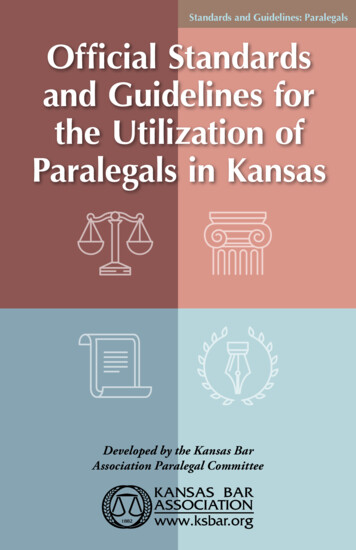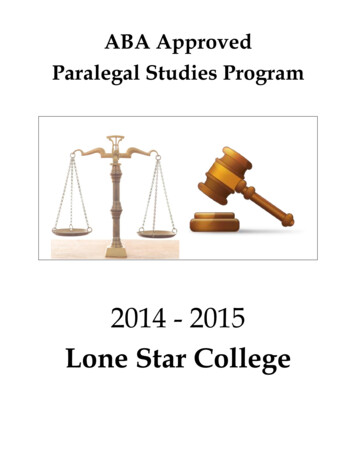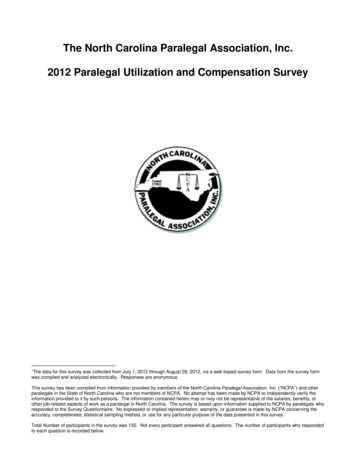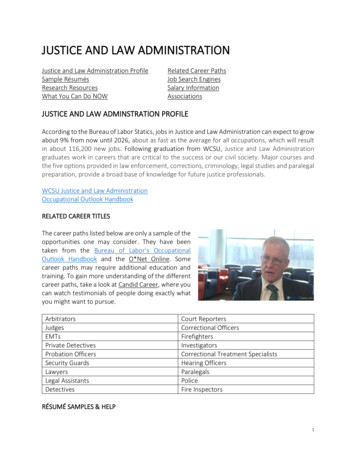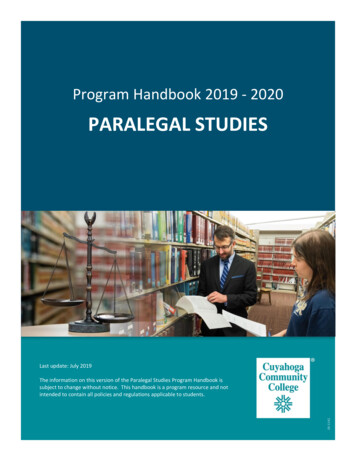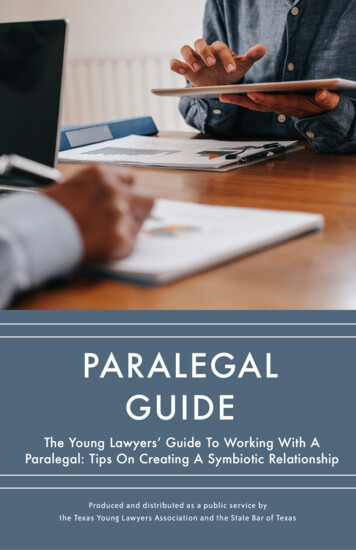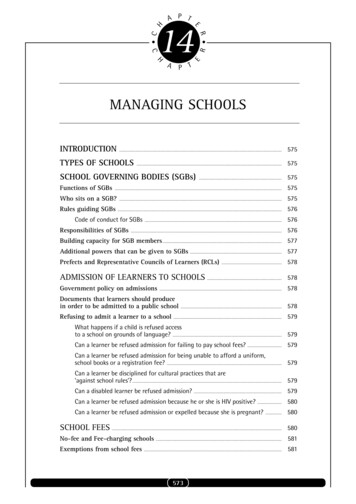
Transcription
A P THRECARCEH14PTMANAGING SCHOOLSINTRODUCTION.TYPES OF SCHOOLS.School governing bodies (SGBs)Functions of SGBs575575.575.575Who sits on a SGB?.575Rules guiding SGBs.576Code of conduct for SGBs.576Responsibilities of SGBs . 576Building capacity for SGB members. 577Additional powers that can be given to SGBs . 577Prefects and Representative Councils of Learners (RCLs) . 578Admission of learners to schools .578Government policy on admissions . 578Documents that learners should producein order to be admitted to a public school . 578Refusing to admit a learner to a school . 579What happens if a child is refused accessto a school on grounds of language? . 579Can a learner be refused admission for failing to pay school fees? . 579Can a learner be refused admission for being unable to afford a uniform,school books or a registration fee? . 579Can a learner be disciplined for cultural practices that are'against school rules'?. 579Can a disabled learner be refused admission? . 579Can a learner be refused admission because he or she is HIV positive? . 580Can a learner be refused admission or expelled because she is pregnant? . 580School fees .580No-fee and Fee-charging schools . 581Exemptions from school fees . 581573
Calculating exemptions from school fees . 581Automatic exemption . 582No exemption . 583Partial exemption . 583Parents with more than one child at school . 583Applying for an exemption in school fees . 584Table for calculating exemptions from school fees . 585Appealing against a decision . 586Discipline in schools .586Kinds of punishment . 586Corporal punishment . 586Suspending a learner from school.586Expelling a learner from school . 586Taking disciplinary action against a learner . 586Complaints of sexual harassment or abuse . 587Language policy in schools .587PROBLEMS1: Parents cannot afford to pay school fees . 5882: Learners are refused admission to a school becauseof outstanding school fees . 589ChecklistRegulations for the exemption of parents from payment of school fees . 590RESOURCES.574691
IntroductionOne of the most important aspects of the South African Schools Act (No 84 of1996) is the law relating to school governing bodies. At the heart of this is the ideaof a partnership between all people with an interest in education. Schools will beimproved only through the joint efforts of parents, educators, learners, members oftheir local communities and various education departments.Types of schoolsSouth African schools have traditionally been classified as either independent(also known as 'private') or public schools. While both types of schools receivefunding from the state, private schools generally demand much higher schoolfees from the parents of children that attend, with the result that they are muchwealthier schools.Public schools are designed to be more inclusive, because the fees they charge aremuch lower.Most public schools that serve poor learners, charge no fees at all. Schools aredivided into five quintiles (20% of schools) according to the levels of income ofparents. The three lowest quintiles (so 60% of all schools) are not allowed to chargeschool fees.Public Schools can be further categorised as “Section 20 or Section 21” Schools.This refers to the section in the Schools Act which allows for the establishment ofthe Schools Governing Body. Section 20 schools receive little money directly but getservices and textbooks paid for by the provincial department. Section 21 schools areable to manage their own finances and purchases, usually charge school fees, andget money from the department.School governing bodies (SGBs)Functions of SGBsThe SA Schools Act Section 20 describes the functions of the school governing body.This includes: Promoting the best interests of the school and its developmentAdopting a constitution and mission statementIntroducing a code of conductProviding support to educators and the principal in carrying out their dutiesDetermining times of the school dayAdministering and controlling the school’s property, and buildings and groundsInvolving parents and others to undertake voluntary duties and tasksRecommending to the Head of Department the appointment of educators andnon-educator staff at the school, subject to the relevant legislation EducatorsEmployment Act, 1994 (Proclamation No. 138 of 1994), and the Labour RelationsAct, 1995 (Act No. 66 of 1995); Managing and allowing the use of school facilities for fundraising, community,and social uses.Who sits on a SGB?There are three groups represented on a governing body: Elected members who can be parents of learners at the school, educators atthe school, staff members who are not educators, such as secretaries and575
gardeners and/or learners at the school who are in grade 8 or above (they mustbe elected by the representative council of learners, which is made up of classrepresentatives) School principal Optional co-opted members who don’t have the right to vote, for example:members of the community, or former learners with specific expertise likeaccounting.The number of parents on a governing body must be one more than half of all ofthe members who may vote. Parents who are employed at a school can only beelected as a representative of staff members not as a representative of parents.Rules guiding SGBsEach governing body must draw up a constitution that says how it will work. Theconstitution must fit into the minimum requirements given by the provincial MECfor Education. The constitution must say: The governing body will meet at least once every school term A separate meeting will be held with each of these groups at least once a year:parents, learners, educators and other staff The governing body will report to parents, learners, educators and other staffat least once a year How minutes of governing body meetings must be keptThe provincial minister of education will publish these details: How the governing body will be elected How long members and office bearers may serve on a governing body How to remove a member from the governing body if there is a good reasonFor doing this How to fill a vacancy What sub-committees must be set up e.g, executive for day-to-day decisions,committees for fund-raising, finance, sport, staff appointments, schoolenvironment and healthEach committee chairperson must be a member of the governing body, but othercommittee members need not be on the governing body.Code of conduct for SGBsThe provincial MEC for Education must draw up a code of conduct for the membersof the SGB after consultation with associations of governing bodies in eachrespective province. All members are required to comply with the code of conduct.The code of conduct must include provisions that allow for disciplinary action tobe taken against a member of the governing body and also protect the memberwho is being disciplined. The Head of Department may suspend or terminate themembership of a governing body member for breaking the code of conduct onceproper disciplinary procedures in terms of the code have been followed. A membermay appeal to the provincial MEC against a decision of the Head of Departmentregarding a suspension or termination of membership as a governing body member.Responsibilities of SGBsThe governing body must: Decide on an admissions policy that doesn’t go against the National Constitution Decide on the language policy of the school Decide on what religious practices will be followed at the school (attending anyreligious practices must be free and voluntary for learners and staff)576
Adopt a code of conduct for learners after consulting with learners, parentsand educatorsA governing body must: Promote the best interests of the school and encourage its developmentby providing quality education for all learners Adopt a constitution Adopt the mission statement of the school (this sets out the values and beliefsof the school) Decide the times of the school day Administer the school property, buildings and grounds Encourage parents, learners, educators and other staff to offer voluntary services Recommend to provincial heads of departments on the appointment of educatorsat the school Allow school facilities to be used by the provincial education department The governing body can allow the community to use its facilities for community,social and school fund-raising purposes.In addition, a governing body can be given any of these functions: Maintaining and improving the school’s property, buildings and grounds Deciding on the extramural curriculum and the choice of subject optionsaccording to provincial curriculum policy Buying textbooks, educational material or equipment for the school Paying for services to the schoolBuilding capacity for SGB MEMBERSThe provincial Head of Department must set up a programme to provide training fornewly elected governing bodies to help them perform their functions.Additional powers that can be given to sgbsThe provincial education department can decide to give additional managementfunctions to school governing bodies that function well and have proved themselves capable of improving their schools.The South African Schools Act identifies two kinds of schools: Section 20 andSection 21 schools. Section 21 schools have greater powers and responsibilities thanSection 20 schools, especially for financial management and purchasing. Section 20schools receive allocations of textbooks and stationery from government. They alsohave their lights and water accounts paid directly by government. When somethingis broken at the school, the Provincial Education Department must send someonefrom Public Works to do the repairs.Section 21 allows a school to apply in writing to the Head of Department foradditional powers. This gives more independence and responsibility to the SGB, butSGBs are encouraged to make application only if they have the capacity required tomanage these additional functions and increased responsibility.Section 21 schools are allocated finances by the department for additional functionswhich include: Maintaining and improving the school's property, and buildings and grounds Deciding on the extra-mural curriculum of the school as well as the choice ofsubject options Purchasing textbooks, educational materials or equipment for the school; Paying for services to the school577
Section 21 school SGBs may also raise money to employ additional staff oreducators – these are often called SGB posts.Prefects and representative councilsOF LEARNERS (RCLs)To promote responsibility and involvement amongst learners in schools, all highschools must hold elections for RCLs. RCLs offer a useful opportunity for youngpeople to learn about leadership and to understand the relationship betweenresponsibility and authority.RCLs are made up of one elected representative per class. The RCL must elect twomembers to represent learners on the SGB.Admission of learners to schoolsGovernment policy on admissionsGovernment policy on school admissions and school fees is guided by three basicprinciples: Equity: to make sure that goverment gives the same basic resources to allgovernment schools Redress: to give more government resources to learners in historicallydisadvantaged communities so that they have more money for textbooks andstationery, and to build schools – especially no-fee schools – in areas where noneexist, and to upgrade existing schools Access: to make sure no one is excluded from attending school on the basis ofrace or religion or because they cannot afford the cost of school fees.The South African Schools Act says that all children between the ages of 5 and 15have to go to school. Children can be accepted in Grade R in the year they turn5 and in Grade One in the year they turn 6 (this applies to both state and privateschools). No learner can be refused admission to a school on the basis of their raceor religion or their inability to pay school fees.No learner registering at a state school can be charged a registration fee or askedto pay fees in advance. No learner can be refused entry to a state school becausehis or her parents have not paid outstanding school fees.Where possible, learners should be given access to a state school within 5 kilometresof their home. In some provinces the education department assists learners withtransport when they live more than 5 kilometres from school.The provincial department of education makes regulations guiding admissions. Hereare some practical steps that can be taken if a school tells a learner that it is full: Ask the principal if the school had been officially declared full by the EducationDepartment. Ask to see the letter which says the school is full. If there is noletter then the school must accept the learner. If the school refuses permissionthen contact the district office If the school does have a letter then the department must find a placefor the learner in the nearest school to where he or she lives.Documents that learners should producein order to be admitted to a public schoolThe Admission Policy for Ordinary Schools says that the only documents parentsneed to show the school when they apply for a learner to be admitted are: The learner’s birth certificate (if the parent is unable to produce a birthcertificate, the school must accept the learner on condition that the parent getsa copy of the birth certificate from the Department of Home Affairs).578
If the learner is transferring from another school, she or he must produce atransfer card, or a report card or any document from the previous school withan affidavit stating why the learner does not have a transfer card. In terms of a person with no documents, the school can still accept the learnerbut the documents must be brought within a reasonable time.Refusing to admit a learner to a schoolWhat happens if a child is refusedaccess to a school on grounds of language?Language cannot be used as a reason to refuse admission to learners. The languagepolicy of the school must reflect that language or languages spoken by the learnersand the school must show how it is promoting multilingualism. Government policyis clear on allowing all learners access to state schools. It also supports mothertongue instruction where this is possible. Some communities have successfullysolved this matter by entering into negotiations with the school governing body.When faced with a problem where a number of learners cannot access a schoolbecause of its language policy, paralegals or community workers can begin byfinding out how many learners are without a school to attend in the community.They can then request a meeting with the Principal and the school governing body.The local Education District Office can also be approached to assist.Can a learner be refused admissionfor failing to pay school fees?The law says that no child can be refused admission to a school because his or herparents cannot afford to pay school fees. It is also illegal for the following to takeplace in relation to fees: To charge registration fees or other advance payments from parents whenadmitting a learner to a school To send a learner home from school because of unpaid school fees To refuse to give the results of tests or exams if fees have not been paid.The law says that the paying of fees is a matter between the SGB and the parentof the learner and not a matter between a learner, educators and/or principals.(See next page School Fees and page 588 Problem 1: Parents cannot afford to payschool fees)Can a learner be refused admission for BEING UNABLE TOAFFORD a uniform, school books or a registration fee?The ability to pay for school uniforms and books is not a condition for admission toa school. Schools are also not allowed to refuse to register learners who cannot paya registration fee. (See page 581 No-fee and Fee-charging schools)Can a learner be disciplined for cultural practices that are'against school rules'?In the case of MEC for Education (KZN) v Navaneethum Pillay the ConstitutionalCourt found that the refusal by a school to allow one of its pupils to wear a smallgold nose stud (which she argued was part of her cultural heritage and identity)constituted unfair discrimination against the pupil on both a cultural and religiousbasis, and the school was ordered to let the pupil wear the nose stud.Can a disabled learner be refused admission?The law says that ‘learners with special education needs’ must in most cases havethe chance to attend ordinary public schools. The school has to follow a process579
where the Head of Department (HOD) first consults parents and other educators tosee if the learner can be admitted. This might include adapting some of the school’sfacilities. If the school feels that they do not have the capacity to admit the learnerthen the law says the HOD must have the learner admitted at another suitableschool in the province. Learners with special needs cannot simply be refusedadmission. These learners are governed by Sections 22–25 of the Admissions Policyfor Ordinary Public Schools.Can a learner be refused admissionbecause he or she is HIV positive?Every learner has a right to be treated: In the same way as other learners With human dignityTherefore no learner may be discriminated against on grounds of his or her HIV status.There is a National Policy on HIV/AIDS for Learners and Educators which aims torespond to the wide variety of circumstances involving HIV/Aids in schools and toacknowledge the importance of SGBs, councils and parents in responding to this.Governing bodies are expected to implement the National Policy by developing andadopting an HIV/AIDS Implementation Plan. The National Policy deals with thefollowing: Non-discrimination and equality with regard to learners and/or educators withHIV/Aids HIV/Aids testing and admission to schools and appointments of educators Attendance at schools by learners with HIV/Aids Disclosure of information and confidentiality Creating a safe school environment to prevent risk of transmission of HIV/Aids,particularly during play and sport Education of HIV/Aids Duties and responsiblities of all learners, educators and parents Consequences of refusing to study with or teach a learner with HIV/Aids, or towork with or be taught by an educator with HIV/Aids School Implementation Plans Health advisory CommitteesYou can find a copy of the full National Policy at www.education.gov.zaCan a learner be refused admissionor expelled because she is pregnant?A learner may not be refused admission to a school or expelled from a schoolbecause she is pregnant. The school principal and the school community shouldlook at ways to support learners who are pregnant. The school is required to providepregnant learners with health information.The Constitutional Court rules in 2013 that expelling a pregnant learner is againstthe law and undermines the right to education.School feesPublic schools are funded by the government and through school fees and/orschool fundraising. Laws and regulations governing school fees are as follows: The South African Schools Act (Act 84 of 1996) as amended by the EducationLaws Amendment Act, 2005 (SASA)580
The Regulations Relating to the Exemption of Parents from the Payment ofSchool Fees, 2006 The Amended National Norms and Standards for School Funding, 2006 The Admission Policy for Ordinary Public Schools, 1998The government pays most of the teachers’ salaries and bigger building costs, andmakes some contribution, per learner, to pay for the equipment and running costs.Over and above the government’s contribution, parents of learners pay school feesthat contribute to finance some schools' operating expenses.According to South African Schools Act (SASA), the SGB of a school must take allreasonable measures within its means to supplement the resources that are suppliedby the government in order to improve the quality of education that is provided toall the learners at the school.No-fee and Fee-charging schoolsSchools are divided up into 5 categories or quintiles, with the poorest schools beingin quintile 1, and the least poor being in quintile 5.The amount contributed by the state in a quintile 1 school (the poorest schoolaccording the quintile status) will be higher than the amount contributed ina quintile 4 or a quintile 5 school (least poor). In other words all these schoolsreceive subsidies but the amount varies depending on which quintile the school isdetermined to be. The amount that the state contributes per learner decreases asyou move up the quintiles.Theoretically, schools falling into quintiles 1 and 2 ought to be no-fee schools, andsome schools falling into quintile 3 may be no-fee schools too, although this isvoluntary in each province. Parents sending their children to these schools shouldnot have to pay any fees, including registration or activity fees.In some instances, the MEC for Education may stipulate that a school will be ano-fee school for learners in Grade R to Grade 9, but will charge fees after this.Exemption from school feesGovernment regulations specify the formula that must be used to calculate whetherparents or caregivers qualify for a full or partial exemption. The formula takes intoaccount the number of school-going children supported by a parent or caregiverand provides specific guidelines for calculating the amount of partial exemptions.In terms of these regulations, certain categories of children are automaticallyexempt from paying fees. These include Child Support Grant beneficiaries andchildren in foster care. In order to work out whether parents or caregivers qualifyfor a full or partial exemption, they will need the following information: What the annual school fees are of the school What the parent or caregiver’s annual income (or earnings) is OR if it is a twoparent household, what the combined gross income is of both parents/care-givers How many learners from the same family attend ‘fee-charging’ schoolsCalculating exemption from school feesWhen applying for an exemption from school fees, the SGB will apply a certainformula. The formula is used to work out what proportion (or percentage) ofthe family income would be spent on school fees. If the school fees are 10% oftheparent/caregiver’s total income, they will be entitled to a full exemption and willnot have to pay school fees.The formula for working out exemption is as follows:E (Exemption) 100 [ F (Annual fees) A (Additional contributions demanded by the school) ][ C (Combined gross income of both parents) ]581
Do this calculation as follows:1. Calculate the amount in the brackets on the top line.This gives the amount in fees that the parent has to pay the school.2. Calculate the amount in the brackets on the bottom line.This gives the income of the parents.3. Divide the top line by the bottom line4. Multiply the figure reached in (3) by 1
The South african Schools act identifies two kinds of schools: Section 20 and Section 21 schools. Section 21 schools have greater powers and responsibilities than Section 20 schools, especially for financial management and purchasing. Section 20 schools receive allocations of textbooks and stationery from government. They also
